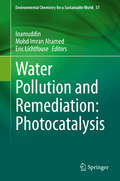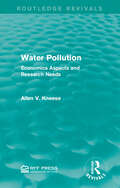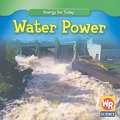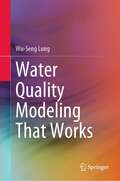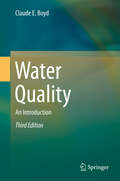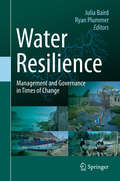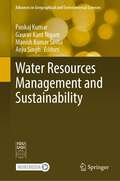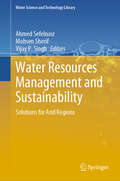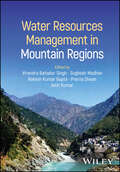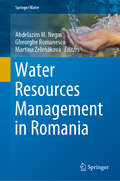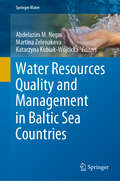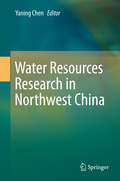- Table View
- List View
Water Pollution and Remediation: Photocatalysis (Environmental Chemistry for a Sustainable World #57)
by Eric Lichtfouse Inamuddin Mohd Imran AhamedIn the context of climate change and fossil fuel pollution, solar energy appears as a cheap and sustainable fuel for many environmental applications, yet the efficiency of techniques has to be improved. This book reviews recent methods and applications of photocatalysis for the treatment of wastewater containing bacteria, heavy metals, organic pollutants, dyes and tannery effluents. Basics of water pollution, polluted river ecosystems and membranes are also detailed.
Water Pollution: Economics Aspects and Research Needs (Routledge Revivals)
by Allen V. KneesePublic agencies and industry will probably spend tens of billions of dollars on new water pollution abatement facilities in the next few decades. Added billions will be spent for the operation of new and existing facilities. How can physical science research reduce the cost of achieving objectives? And how can social science research make sure that the right objectives are being efficiently pursued? This title, first published in 1962, is directed to the orientation of the research effort, and the tool used for this purpose is an economic framework. This book will be of interest to students of economics and environmental studies.
Water Power
by Tea BenduhnIf you've ever seen a crashing ocean wave or a rushing waterfall, you've seen water power in action. People have used flowing water to do work for centuries. Today, water power is a dependable resource for making electricity. Learn why water is such a great source of energy and the different ways we might use it in the future.
Water Productivity in Rainfed Agriculture: Redrawing the Rainbow of Water to Achieve Food Security in Rainfed Smallholder Systems (IHE Delft PhD Thesis Series)
by Hodson MakuriraThe challenge of water scarcity as a result of insufficient seasonal rainfall and dry spell occurrences during cropping seasons is compounded by inefficient agricultural practices by smallholder farmers where insignificant soil and water conservation efforts are applied. The hypothesis of this research is that many of the past research efforts have
Water Quality Impacts of the Energy-Water Nexus
by Erika Weinthal Avner VengoshEnergy and water have been fundamental to powering the global economy and building modern society. This cross-disciplinary book provides an integrated assessment of the different scientific and policy tools around the energy-water nexus. It focuses on how water use, and wastewater and waste solids produced from fossil fuel energy production affect water quality and quantity. Summarizing cutting edge research, it describes the scientific methods for detecting contamination sources in the context of policy and regulations. The authors highlight the growing evidence that fossil fuel production, from both conventional and unconventional sources, leads to water quality degradation, while regulations for the water and energy sector remain fractured and highly variable across and within countries. This volume will be a key reference for scholars, industry professionals, environmental consultants and policy makers seeking information on the risks associated with the energy cycle and its impact on the environment, particularly water resources.
Water Quality Modeling That Works
by Wu-Seng LungThis book offers a practical guidance for environmental engineers and scientists charged with assessing the cause-and-effect of pollutants in receiving water systems. Instead of blindly running models, which is a practice seen too often in today’s field that can result in results with uncertainty, modelers must first understand the physical insights of the specific water systems in order to properly calibrate the parameters of the models. This book reinforces the critical importance of properly understanding the physical attributes of water systems by drawing on the author’s extensive experience in modeling with strong data support. This is also what sets this book apart from the volumes currently available in the water quality modeling field – nearly all other books in the field are categorized as textbooks, and unlike this book, offer few practical examples or exercises to follow. Environmental engineers and scientists engaged in quantifying the water quality impacts of pollutants to specific water systems will find this book valuable in their day-to-day practices. This book is a necessary volume for water quality engineers and scientists to consult for the regulatory planning and management of water systems
Water Quality Modelling for Rivers and Streams
by George Tsakiris Marcello BenediniThe main objective of the Water Framework Directive in the European countries is to achieve a "good status" of all the water bodies, in the integrated management of river basins. In order to assess the impact of improvement measures, water quality models are necessary. During the previous decades the progress in computer technology and computational methods has supported the development of advanced mathematical models for pollutant transport in rivers and streams. This book is intended to provide the fundamental knowledge needed for a deeper understanding of these models and the development of new ones, which will fulfil future quality requirements in water resources management. This book focuses on the fundamentals of computational techniques required in water quality modelling. Advection, dispersion and concentrated sources or sinks of contaminants lead to the formulation of the fundamental differential equation of pollutant transport. Its integration, according to appropriate initial and boundary conditions and with the knowledge of the velocity field, allows for pollutant behaviour to be assessed in the entire water body. An analytical integration is convenient only in one-dimensional approach with considerable simplification. Integration in the numerical field is useful for taking into account particular aspects of water body and pollutants. To ensure their reliability, the models require accurate calibration and validation, based on proper data, taken from direct measurements. In addition, sensitivity and uncertainty analysis are also of utmost importance. All the above items are discussed in detail in the 21 chapters of the book, which is written in a didactic form for professionals and students.
Water Quality: An Introduction (Aquaculture Ser.)
by Claude E. BoydThis volume is of great importance to humans and other living organisms. The study of water quality draws information from a variety of disciplines including chemistry, biology, mathematics, physics, engineering, and resource management.University training in water quality is often limited to specialized courses in engineering, ecology, and fisheries curricula. This book also offers a basic understanding of water quality to professionals who are not formally trained in the subject.The revised third edition updates and expands the discussion, and incorporates additional figures and illustrative problems. Improvements include a new chapter on basic chemistry, a more comprehensive chapter on hydrology, and an updated chapter on regulations and standards.Because it employs only first-year college-level chemistry and very basic physics, the book is well-suited as the foundation for a general introductory course in water quality. It is equally useful as a guide for self-study and an in-depth resource for general readers.
Water Resilience: Management and Governance in Times of Change
by Ryan Plummer Julia BairdThis book synthesizes current knowledge and understanding of management and governance in the context of water resilience; advances theory through synthesis of research and experiences from a variety of disciplinary perspectives. The book highlights the implications of theory and experience for innovation in practice and policy; and it explores frontiers and future research. The book further addresses the need for a consolidated, interdisciplinary approach to the theoretical advances and practical implications of water resilience for academics, resource managers, aid organizations, policy makers and citizens.
Water Resource Economics, second edition: The Analysis of Scarcity, Policies, and Projects
by Ronald C. GriffinUpdated edition of a comprehensive introduction to the economics of water management, with self-contained treatment of all necessary economic concepts.Economics brings powerful insights to water management, but most water professionals receive limited training in it. The second edition of this text offers a comprehensive development of water resource economics that is accessible to engineers and natural scientists as well as to economists. The goal is to build a practical platform for understanding and performing economic analysis using both theoretical and empirical tools. Familiarity with microeconomics or natural resource economics is helpful, but all the economics needed is presented and developed progressively in the text.The book focuses on the scarcity of water quantity (rather than on water quality). The author presents the economic theory of resource allocation, recognizing the peculiarities imposed by water, and then goes on to treat a range of subjects including conservation, groundwater depletion, water law, policy analysis, cost–benefit analysis, water marketing, privatization, and demand and supply estimation. Added features of this updated edition include a new chapter on water scarcity risk (with climate change and necessary risk tools introduced progressively) and new risk-attentive material elsewhere in the text; sharper treatment of block rates and pricing doctrine; expanded attention to contemporary literature and issues; and new appendixes on input–output analysis, water footprinting and virtual water, and cost allocation. Each chapter ends with a summary and exercises.
Water Resource Management
by David E. McnabbThis book is about how water managers in the United States are responding to the call for increased effort to achieve sustainable supplies of clean fresh water for present and future generations. The author, himself a participant in the water supply chain, demonstrates that while water is indeed one of life's most essential commodities, in many parts of the United States it is one of the most stressed resources. Throughout the book the author illustrates both the good and the bad efforts taken or not taken by water and wastewater management with real life examples. This book will appeal to the educators, students, volunteers, elected officials, regulators, and other participants with a role in helping the suppliers of water and wastewater services to achieve their goals providing clean, safe water on a sustainable basis.
Water Resource Management in Central Asia and Afghanistan: Current and Future Environmental and Water Issues (Springer Water)
by Zheenbek E. Kulenbekov Baktyiar D. AsanovThe book provides a cross-sectoral, multi-scale assessment of development-directed investigations in the main rivers of wider Central Asia and Afghanistan. The book highlights the development of river systems, water reservoirs, ecosystems and risks as well as the impact of climate change on water resources in Central Asian countries and Afghanistan. It provides information on the genesis of river basins, physical and chemical properties of water in rivers, and the hydrological regimes of the rivers of Central Asia and Afghanistan. The book is useful for scientists and researchers whose work focuses on rivers and the use of water resources, irrigation, ecosystems, risks, water supply, climate change and remote sensing, as well as for students and planners, administrations and other stakeholders in the water sector.
Water Resource Management in Climate Change Scenario: Innovations in Geospatial Techniques and Models (GIScience and Geo-environmental Modelling)
by Shakeel Ahmed Atiqur Rahman Swapan Talukdar Shahfahad Swades Pal Mohd Waseem NaikooThis book seeks to showcase the ongoing challenges of water resource and its management through innovative and cutting-edge approaches (flooding and droughts and their respective impacts; spatial and urban planning; early warning systems; estimation of losses; water resource in the age of global climate change; risk communication; meteorology; integrated analysis; risk mitigation; infrastructures; nature-based management; watershed management; transport; legal assessment; vulnerability analysis; public participation; or case studies). In the face of current global changes, the availability and quality of water resources are under severe threat. Indeed, in all sectors related to water resource management, sustainable development is important for present and future generations. Indeed, multiple problems such as water shortage or flooding, as well as environmental pollution phenomena, are observed. This situation is further exacerbated by poor management practices and unsustainable extraction of water for various consumptive uses. Consequently, many regions around the world, particularly urban areas, are becoming water stressed and conflicts over access to water are becoming ever more common. To overcome the significant challenges fundamental to the management of water resources, cutting-edge knowledge, innovative approaches, and an in-depth understanding of the inherent scientific, economic, social, and environmental issues are imperative. Therefore, water resource management requires a clear understanding of the ongoing challenges and innovative approaches. The authors and editors believe that this book provides huge knowledge and data in the fields of water resource management, earth environmental sciences, humanities, and social sciences, which target a diverse range of readers, such as academics, scientists, students, environmentalists, meteorologists, urban planners, remote sensing, and GIS experts.
Water Resources Management and Reservoir Operation: Hydraulics, Water Resources and Coastal Engineering (Water Science and Technology Library #107)
by Vijay P. Singh Ramakar Jha Vivekanand Singh L. B. Roy Roshni ThendiyathThis book explores many recent techniques including ANN, fuzzy logic, hydraulic models and IWRM utilized for integrated water resources management, a real challenge in India for obtaining high irrigation efficiency.The book deals with topics of current interest, such as climate change, floods, drought, and hydrological extremes. The impact of climate change on water resources is drawing worldwide attention these days; for water resources, many countries are already stressed and climate change along with burgeoning population, rising standard of living, and increasing demand are adding to the stress. Further, river basins are becoming less resilient to climatic vagaries. Fundamental to addressing these issues is hydrological modelling which is covered in this book Further, integrated water resources management is vital to ensure water and food security. Integral to the management is groundwater and solute transport. The book encompasses tools that will be useful to mitigate the adverse consequences of natural disasters.
Water Resources Management and Sustainability (Advances in Geographical and Environmental Sciences)
by Pankaj Kumar Anju Singh Gaurav Kant Nigam Manish Kumar SinhaWater is the elixir of life and is crucial for sustainable development. Earlier, it was considered to be a limitless or at least a fully renewable natural resource. During the past 20 years, however, there has been tremendous pressure on this precious natural resource mainly due to rapid urbanization, industrialization and the increase in the human population. Together, these have resulted in increasing demand for irrigation, industrial, and household purposes to meet supply-chain requirements. Keeping in mind the scarcity of available water resources in the near future and its impending threats, it has become imperative on the part of scientists in hydrology and allied disciplines such as geography, landscape planning, sustainability science etc. Regional planners and supply chain management experts also must be involved in studying the spatial and temporal nature of the growing demand for water and the future availability for its judicial use and sustainable management. A primary intent of the book is to provide comprehensive scientific knowledge base on water resource management and sustainability. It covers geo-engineering and scientific problems, case studies, and sustainable solutions in the water resources management domain. Additionally and of equal importance, the chapters of the book provide in-depth coverage on water resource vulnerability, water quality, wastewater treatment, application of remote sensing and geographical information systems hydrological modeling and harvesting, climate variability and runoff, sediment discharge and irrigation planning, community participation in water governance, internet of things and machine learning applications for sustainable water resources management. This practical, state-of-the-art reference book is a valuable resource for students, researchers, scientists, policymakers, spatio-temporal designers of water resource systems, various stake holders interested in hydro-climatology and sustainable water resources management.
Water Resources Management and Sustainability: Solutions for Arid Regions (Water Science and Technology Library #114)
by Vijay P. Singh Mohsen Sherif Ahmed SefelnasrThe first section deals with hydrological topics, problems, and principles. In this chapter, detailed studies related to hydrological monitoring are carried out. Overland flow velocity estimation, wireless sensor networks, and application of deep learning techniques are discussed. These topics are helpful to estimate overland flow velocities using tracer techniques based on the infrared thermography and fluorescent properties of quinine which can help in the visualization of shallow flows, evaluation of high-resolution rainfall measurement, and extracting water bodies from high-resolution drones and satellite imagery using an integrated deep learning method. The chapter critically discusses the advantage of thermal tracers, utilizing the wireless sensor networks for the accurate capture of spatially varied precipitation patterns, and evaluation and quality assessment of water extraction using deep learning techniques. It highlights recommendations and limitations that should be taken into account for hydrological monitoring. Moreover, this section discusses rainfall and floods and their related attributes in arid regions, including flood mitigation and risk assessment. Flood mapping and assessment, recent trends of floods and their impacts are comprehensively discussed. The outcomes are for useful hydrologic infrastructure design under changing climate. This part also highlights the importance of applying new methodologies, considering the statements and questions asked by scientists and researchers. The second section addresses droughts and their analysis and assessment. Drought events are great challenges faced by nature in the wake of climate change. This part will help stakeholders gather useful information and develop a deep understanding of these salient features of climate change's impacts. It deals with the various studies conducted in the field of drought and flash drought. Flash drought is a composition of various factors leading to intense drought conditions. So, limitations and recommendations to mitigate drought events are discussed in detail. The third section discusses groundwater as an important component in the water budget in arid regions. Threats, recharges, quality, and management options of this resource are also discussed. Beginning with a perspective on the management of this resource, the papers go on to discuss rational decision making, challenges, use of information technology, integrated management, and modeling for groundwater resources management. Section four deals with water quality. This part discusses modern techniques for water quality assessment and treatment procedures. The industrial and commercial area generates a large amount of waste which is indiscriminately disposed of. leading to several environmental issues. This section provides a detailed analysis on water quality, hydrogeochemistry, impact and benefits of treating municipal wastewater to tertiary quality, groundwater table and quality deterioration. Recommendations for adequate planning, design, construction, and location of open dumpsites to ameliorate groundwater pollution, and the closing of trace metal boreholes to avoid possible health implications or outbreaks that are likely occurring or are expected to occur. Section five discusses water resources management. This topic has been receiving a fair amount of attention in many arid countries of the world and more specifically in the Gulf region. This section addresses regulations for conservation, reuse, and security. The limited freshwater resources must be developed, managed, and used as efficiently as possible. Decision support systems for water resources planning, management, and water rights analyses and control have been discussed as well.
Water Resources Management and Sustainability: Solutions for Arid Regions (Water Science and Technology Library #121)
by Vijay P. Singh Mohsen Sherif Ahmed Sefelnasr M. AbrarThe book will be of interest to researchers and practitioners in the field of hydrology, environmental engineering, agricultural engineering, earth sciences, and watershed and range sciences, as well as to those engaged in water resources planning, development and management in arid and semi-arid areas. Given the lack of literature on arid regions, this book not only provides an assessment of water resource management in arid regions but also addresses solutions, and it can also be an outstanding textbook on water resources management and sustainability for arid regions.This volume in the Water Science and Technology Library includes selected papers that have been presented and discussed during the International Water Resources Management and Sustainability: Solutions for Arid Regions, 22–-24 March 2022, Dubai, United Arab Emirates. The conference was organized by the National Water and Energy Center, UAE University, in collaboration with the South Australian Goyder Institute for Water Research, and the Department for Environment and Water, Government of South Australia. The conference attracted a large number of nationally and internationally well-known experts who have been at the forefront of water resources management and sustainability in arid and semi-arid regions. More than 55 countries, covering the five continents, were represented. The conference was designed to facilitate and encourage new perspectives on how science and innovative technologies can transform water management and sustainability in arid and semi-arid regions around the world. It addressed current challenges and priorities in water management and provided a forum to share knowledge, experiences, research, and discoveries.
Water Resources Management and Water Pollution Control: Conference Proceeding of 2023 the 6th International Symposium on Water Pollution and Treatment (ISWPT 2023) (Environmental Science and Engineering)
by Zhanhong WanThis book features select peer-reviewed proceedings from the 6th International Symposium on Water Pollution and Treatment (ISWPT 2023). It comprises articles written by researchers, practitioners, policymakers and entrepreneurs that examine recent advancements in water pollution and treatment. The book covers a range of topics, including the impact of climate change on water pollution and technologies for reducing greenhouse emissions in water and wastewater treatment. Additionally, it explores water resources planning and management, water quality protection and technologies and processes that control water pollution. This book is useful for beginners, researchers and professionals working in the area of water pollution management, policy and governance.
Water Resources Management in Balkan Countries (Springer Water)
by Gheorghe Romanescu Abdelazim M. Negm Martina ZelenakovaThis book presents an overview and knowledgeable on water resources management in Balkan countries – Slovenia, North Macedonia, Serbia, Croatia, Greece, and Bulgaria.The book shows the state of the art and also the latest research findings of the different aspects of water resources management in Balkan countries with case studies that reveal the best practice in water resources management, development, and protection. Researchers and scientists from the Balkan countries present their experiences and expertise on a wide range of water resources topics.Therefore, the book is of particular interest to decisions planners/makers and stakeholders. Also, the book will be useful to experts, professionals, researchers, scientists, practitioners, academics working in the field of water resources management in Balkan countries and analogous regions.
Water Resources Management in Central Asia (The Handbook of Environmental Chemistry #105)
by Andrey G. Kostianoy Igor S. Zonn Aleksandr V. Semenov Sergey S. ZhiltsovThis book reviews the current status of water resources management in Central Asian countries, and outlines the history, policies and cross-border cooperation regarding water resources management in the region. Particular attention is paid to the evolution of water resources management in Central Asia, past and future water transfer projects, specific problems concerning water use and pollution, and national approaches to water management in Kazakhstan, Kyrgyzstan and Tajikistan, as well as to related conflicts between the Central Asian countries. Together with the companion volumes on Water Resources in Central Asia: International Context and Water Bodies and Climate Change in Central Asia, it offers a valuable source of information for a broad readership, from students and scientists interested in the environmental sciences, to policymakers and practitioners working in the fields of water resources policy and management, international relations, and environmental issues.
Water Resources Management in Mountain Regions
by Amit Kumar Rakesh Kumar Gupta Sughosh Madhav Virendra Bahadur Singh Prerna DiwanAn up-to-date and comprehensive analysis of mountainous region water resource management In Water Resources Management in Mountain Regions, a team of distinguished researchers delivers an up-to-date survey of mountain region hydrology, including the assessment, dynamics, and modeling of glaciers, rivers, and lakes, as well as coverage of the impact of climate change and anthropogenic activities on mountain ecosystems. The authors discuss the challenges posed for those attempting to sustainably manage water resources and explain the impacts of those challenges on water yield, water quality, and the risk of flash flooding. The book includes several case studies from the Himalayan mountain range, which serves as a model region for both medium-high and very high-altitude water resources. It also examines traditional methods of water resource management and conservation and their relevance for 21st century strategies. Readers will also find: A thorough introduction to the management challenges of water resources in the Sikkim Mountain regionsComprehensive explorations of the microbial dynamics, ecological resilience, and sustainable management strategies of mountainous water resourcesPractical discussions of the application of Geographic Information Systems and Remote Sensing in Satpuda mountainous terrainComplete examinations of water resource vulnerability to climate change in the mountain regions of India Perfect for scientists and other professionals working in surface and subsurface hydrology, environmental management, and climate science, Water Resources Management in Mountain Regions will also prove invaluable to professionals working in companies and governmental institutions involved in water resource exploitation and conservation, hydroelectric power generation, and disaster prevention.
Water Resources Management in Romania (Springer Water)
by Martina Zeleňáková Gheorghe Romanescu Abdelazim M. NegmThis book discusses water resources management in Romania from a hydrological perspective, presenting the latest research developments and state-of-the-art knowledge that can be applied to efficiently solve a variety of problems in integrated water resources management. It focuses on a wide range of water resources issues – from hydrology and water quantity, quality and supply to flood protection, hydrological hazards and ecosystems, and includes case studies from various watersheds in Romania. As such, the book appeals to researchers, practitioners and graduates as well as to anybody interested in water resources management.
Water Resources Management of the People’s Republic of China: Framework, Reform and Implementation (Global Issues in Water Policy #26)
by Dajun ShenThis book explores water resources management issues in China and possible solutions. It analyzes a wide range of general and specific topics, providing case studies and a balanced review of the past and present situation as well as future developments. The book begins with a general introduction and an overview of hydrology, water resources, and development issues in China. It then presents a management framework, including a management system, management institutions, river basin management, water pricing, water rights, and groundwater management, and discusses its implementation, covering water resources allocation and regulation in the Yellow River, integrated water affair management reforms, and agricultural water management in northern China. The last section focuses on the current reforms and hot topics, with strong emphasis on stringent water resource strategies applied to the river and lake principle system, recycled water use and water resources asset management, as well as climate change impacts, and concludes with a summary of the many changes in the water sector in China and a look at the road ahead and the areas that still need to be reformed.
Water Resources Quality and Management in Baltic Sea Countries (Springer Water)
by Abdelazim M. Negm Martina Zelenakova Katarzyna Kubiak-WójcickaThis unique book shares the knowledge and experience of experts and scientists who apply high-quality findings and input from their research to issues concerning the management of water resources and their quality in Baltic countries including Poland, Lithuania, Latvia, Germany and Russia. It summarizes the latest results of several systematic investigations, and assesses the occurrence and quality of surface and underground waters within the Baltic countries to help decision-makers plan for sustainable development. The book addresses a range of water resources management issues, especially those that are relevant to the water quality in these Baltic countries. It presents cutting-edge information and findings that can be effectively used to solve a variety of problems in integrated water resources management. Accordingly, it will be of interest to graduate students, researchers, water scientists, professionals, experts and practitioners working in water resources management.
Water Resources Research in Northwest China
by Yaning ChenThis book examines the possible impacts of climate change on hydrology and water resources in the vast arid region of Northwest China, which is one of the world's largest arid places. The first chapter offers an introductory discussion of the physical geography and socioeconomic conditions in the region. Chapters 2 through 7 discuss the climate system and hydrologic system changes in the region, and assess some implications of these changes in relation to potential evapotranspiration, the hydrological cycle and spatiotemporal variations of the snow cover and glaciers as measured via remote sensing, geographic information systems, and statistical analysis. Chapters 8 and 9 focus on model description and experimental design for interpreting the hydro-climatic process, emphasizing the integration of water, climate, and land ecosystems through field observations and computer-based simulations. Chapter 10 examines some extreme hydrological events and presents a study using the historical trend method to investigate the spatial and temporal variability of changing temperature and precipitation extremes in the hyper-arid region of Northwest China. A concluding chapter discusses possible strategies for sustainable watershed management. The contributors are acknowledged experts who bring broad, relevant experience on water resources research in China's cold and arid regions. The lessons of this volume will prove useful for understanding arid areas elsewhere in the world.
